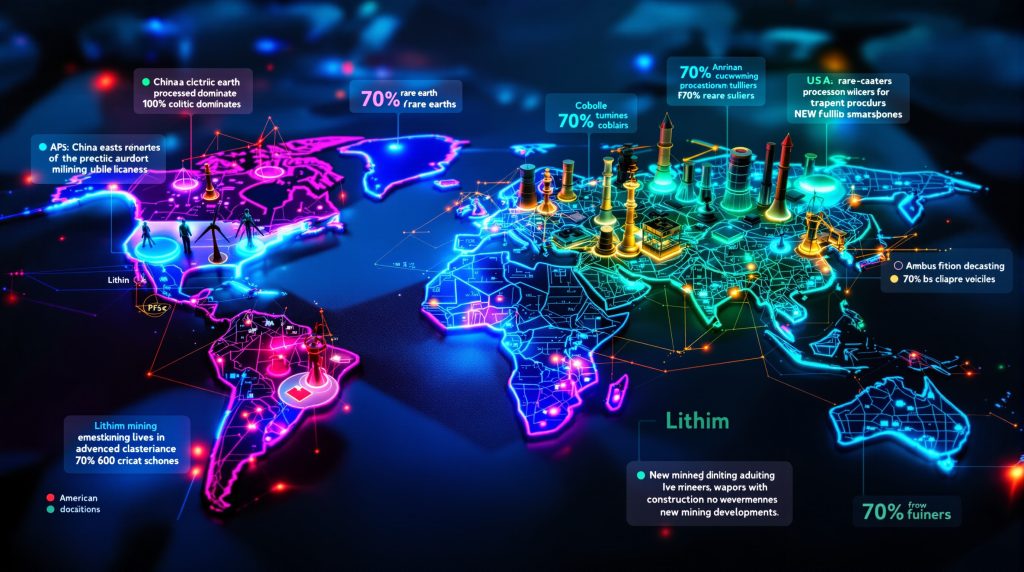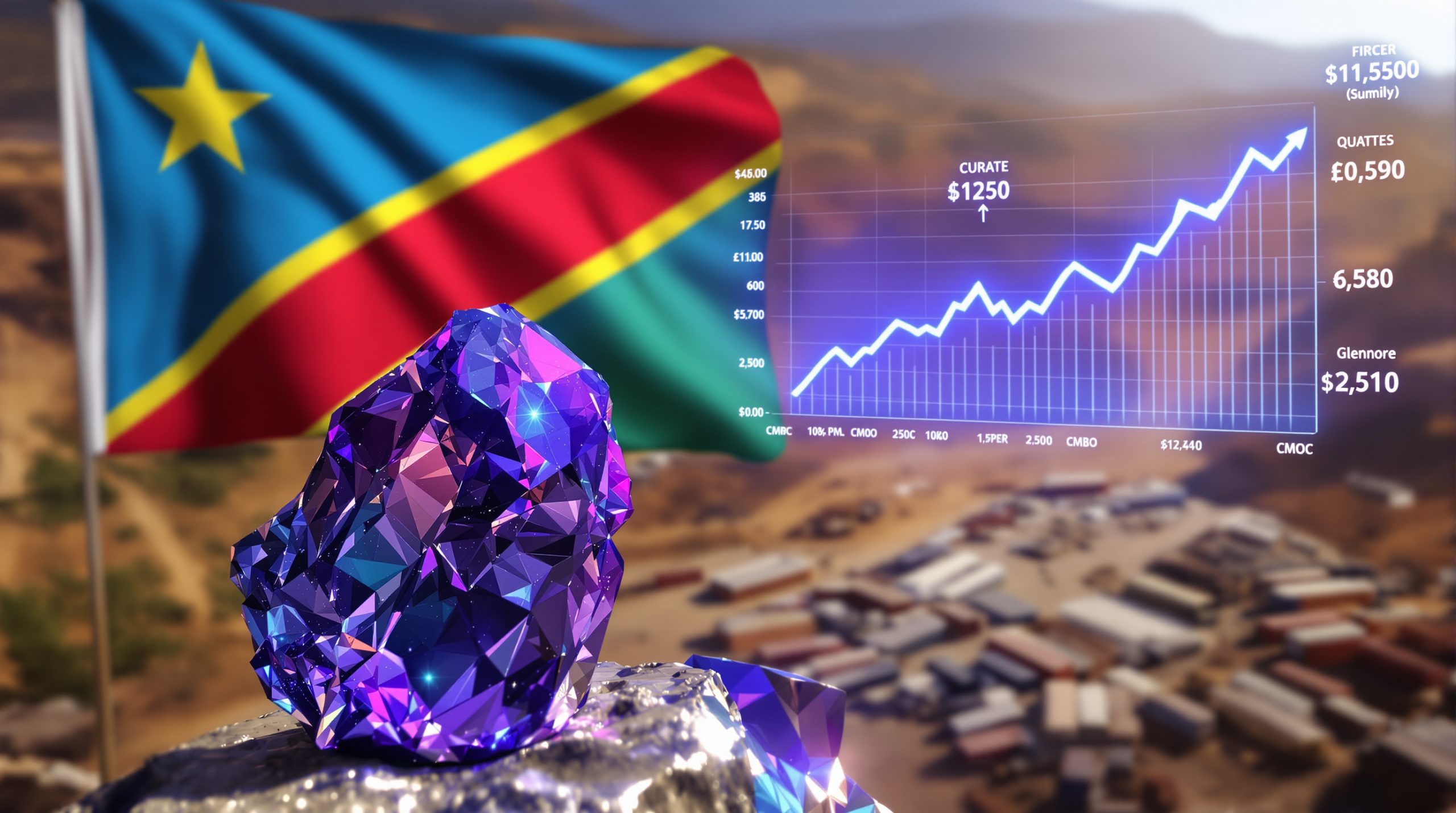How is the US Countering Chinese Dominance in Critical Minerals?
Critical minerals form the backbone of modern economies, powering everything from renewable energy technologies to defense systems and consumer electronics. As geopolitical tensions rise, the United States is taking unprecedented steps to challenge China's long-established dominance in the critical minerals supply chain. This strategic pivot represents one of the most significant industrial policy shifts in recent American history, with implications for global trade, national security, and the critical minerals energy transition.
The US government's multibillion-dollar fund partnership with Orion Resource Partners signals a dramatic escalation in efforts to secure supply chains for materials essential to advanced technologies and clean energy transition. With China controlling up to 90% of processing for some critical minerals, this initiative represents a direct challenge to Beijing's market dominance.
What Are Critical Minerals and Why Do They Matter?
Critical minerals include copper, cobalt, lithium, rare earth elements, and numerous other materials essential for advanced technologies. These resources are designated as "critical" because they serve vital functions in modern manufacturing, face supply chain vulnerabilities, have limited substitution options, and are strategically important for national security and economic prosperity.
These minerals power a vast array of applications that define modern life:
- Electric vehicle batteries require lithium, cobalt, nickel, and graphite
- Wind turbines depend on rare earth elements for permanent magnets
- Defense systems utilize specialized alloys containing rare metals
- Electronics require minute amounts of numerous critical minerals
- Solar panels contain various critical elements including silver, indium, and gallium
The criticality of these resources has intensified with accelerating digital transformation and renewable energy adoption. A single F-35 fighter jet, for example, contains nearly 920 pounds of rare earth elements, highlighting the national security dimensions of mineral supply.
China's Dominant Position in the Global Minerals Market
How China Established Market Control
China's dominance in critical minerals didn't happen by accident. Through decades of strategic investment and policy support, China has established:
- Long-term strategic planning focused on securing resource access
- Massive domestic investment in processing technology and capacity
- Aggressive overseas acquisitions of mining assets
- Integration of mineral resources into foreign policy and the Belt and Road Initiative
- State subsidies for critical mineral companies
- Less stringent environmental regulations reducing operational costs
- Talent development programs focused on metallurgy and mineral processing
This market concentration gives China significant leverage in global supply chains and technology development, creating vulnerabilities for Western economies. During trade tensions, China has occasionally hinted at restricting rare earth exports as leverage, underscoring the geopolitical implications of resource control.
The Scale of Chinese Processing Dominance
| Critical Mineral | China's Share of Global Processing | Primary Applications |
|---|---|---|
| Rare Earth Elements | ~90% | Permanent magnets, electronics, catalysts |
| Cobalt | ~70% | Batteries, superalloys, magnets |
| Graphite | ~80% | Batteries, electrodes, lubricants |
| Lithium | ~60% | Batteries, ceramics, lubricants |
| Nickel (for batteries) | ~65% | EV batteries, stainless steel |
This processing dominance represents a more significant chokepoint than raw material production. While mining occurs globally, the complex processing facilities required to transform ore into usable materials are heavily concentrated in China, creating a funnel effect in global supply chains.
The US Strategic Response: A Multi-Faceted Approach
The Proposed Critical Minerals Fund
At the center of America's counter-strategy is a proposed multibillion-dollar fund focused on overseas mining investments. Key elements include:
- Partnership between the US International Development Finance Corporation (DFC) and Orion Resource Partners
- Initial commitments of approximately $600 million from each partner
- Potential for additional sovereign investors and US agencies to participate
- Focus on extracting and processing minerals essential for clean energy and defense
According to Bloomberg reporting, negotiations between Orion and the DFC began in early 2024 but faced delays due to questions from Commerce Secretary Howard Lutnick. Most of these concerns have reportedly been addressed, allowing the initiative to move forward.
How Will the Fund Be Structured?
The proposed investment structure includes:
- $100 million for equity stakes in mining projects
- $500 million for debt financing
- Focus on overseas investments due to DFC's mandate limitations
- Potential to leverage additional private sector capital
The fund's structure reflects the constraints of the DFC's mandate, which limits its investments to projects outside the United States. This offshore focus may actually complement domestic initiatives by ensuring secure supply chains across multiple jurisdictions.
Beyond the Fund: Complementary US Initiatives
The fund represents just one component of a broader US mineral production policy that includes:
-
Domestic Production Incentives: Federal funding to accelerate mining and processing within US borders
-
Technology Development: Research funding for alternative materials and more efficient extraction methods
-
International Partnerships: Strengthening supply chain cooperation with allies like Australia, Canada, and European nations
-
Regulatory Streamlining: Efforts to expedite permitting for critical mineral projects
-
Strategic Stockpiling: Building reserves of essential materials through the Defense Logistics Agency
This multi-pronged approach aims to address vulnerabilities across the entire supply chain, from exploration and mining to processing and manufacturing.
Why is This Fund Significant for Global Mineral Markets?
Catalyzing Private Investment
The public-private partnership model could mobilize significant capital beyond direct government investment. As Gracelin Baskaran, director of the Critical Minerals Security Programme at the Center for Strategic and International Studies, noted, this approach "aligns financial tools with broader mineral ambitions" and could catalyze substantial private sector investment.
The fund's significance extends beyond its direct financial impact:
- Signals government backing for critical mineral projects, reducing perceived risk
- Provides anchor investment that can attract additional private capital
- Addresses financing gaps for projects in challenging jurisdictions
- Offers patient capital with longer time horizons than typical private investors
- Combines public policy objectives with private sector expertise
Shifting Global Supply Chains
The fund signals a more assertive US approach to critical minerals, potentially:
- Diversifying global supply chains away from Chinese dominance
- Creating new opportunities for mining jurisdictions outside China's sphere of influence
- Accelerating development of projects that might otherwise struggle to secure financing
- Building more resilient supply networks for Western economies
For mining companies, this initiative creates new pathways to project development in an industry where securing capital often represents the most significant hurdle.
What Challenges Does the US Strategy Face?
Time Horizons and Development Realities
Mining projects typically require 5-10 years from discovery to production, creating a significant lag between investment and supply impact. This timeline challenge includes:
- Lengthy permitting processes in many jurisdictions
- Technical challenges in extraction and processing
- Infrastructure development requirements
- Environmental impact assessments and mitigation
This reality means that even with aggressive investment today, supply chain vulnerabilities will persist for years. The initiative faces a race against accelerating demand growth from electric vehicles, renewable energy, and other advanced technologies.
Processing Capabilities Gap
While mining investment is crucial, processing capacity represents an even more significant bottleneck. China's dominance in processing creates challenges for:
- Converting raw materials into usable forms
- Meeting specifications for high-tech applications
- Scaling processing capacity to match mining output
- Developing the technical expertise needed for advanced processing
Building competitive processing facilities outside China requires not just capital but also specialized knowledge, infrastructure, and regulatory frameworks. The US currently lacks commercial-scale rare earth separation capacity, highlighting the magnitude of the challenge.
Environmental and Social Considerations
Critical mineral development brings significant environmental and social challenges:
- Water usage and potential contamination concerns
- Land disturbance and habitat impacts
- Community relations and indigenous rights issues
- Carbon emissions from energy-intensive processing
Environmental Consideration: Modern processing facilities for rare earth elements can reduce environmental impact by up to 90% compared to conventional methods, but require substantially higher initial investment and operating costs.
These considerations create additional complexity for project development and may extend timelines beyond projections, particularly in jurisdictions with robust environmental protections.
The DFC's Expanding Role in Critical Minerals
The DFC has already made notable investments in the mining sector, including:
- $105 million for mining start-up TechMet
- $50 million in a South African rare earths project
The proposed partnership with Orion would represent its largest mining-focused initiative to date, significantly expanding its role in critical mineral supply chains.
This evolution reflects a growing recognition that development finance can serve both economic development and strategic interests simultaneously. Mining projects create jobs and economic activity in host countries while also serving broader supply chain resilience objectives.
Who is Orion Resource Partners?
Orion Resource Partners brings significant mining finance expertise to the partnership:
- Led by CEO Oskar Lewnowski
- Manages approximately $8 billion in assets
- Specializes in mining and commodities investments
- Provides both equity and debt funding to mining projects
- Operates a hedge fund arm focused on commodities
Orion's involvement provides critical sector expertise to complement the DFC's development finance capabilities. The firm's experience in structuring mining investments across jurisdictions enables efficient capital deployment in a complex sector.
How Does This Initiative Fit Into Broader US Industrial Policy?
The Bipartisan Nature of Critical Minerals Strategy
Support for critical minerals strategy has transcended political divisions, with administrations from both parties prioritizing:
- Supply chain resilience and domestic production
- Reduced dependence on Chinese processing
- Strategic investments in mineral security
- Public-private partnerships to accelerate development
This policy continuity reflects the fundamental strategic importance of critical minerals, regardless of which party controls the White House or Congress.
Integration With Clean Energy and Defense Strategies
The critical minerals push aligns with other strategic priorities:
- Supporting clean energy manufacturing and deployment
- Strengthening defense industrial base capabilities
- Advancing semiconductor and high-tech manufacturing
- Promoting economic competitiveness in strategic sectors
This alignment creates mutually reinforcing policy objectives, where investment in critical minerals simultaneously supports climate goals, national security, and economic development.
What Are the Implications for Global Mining Companies?
New Funding Opportunities
The initiative creates potential opportunities for:
- Junior mining companies developing critical mineral projects
- Mid-tier producers looking to expand operations
- Service providers in the mining supply chain
- Processing and refining companies
Companies positioned in critical mineral exploration and development may find more favorable financing terms and greater investor interest as strategic importance elevates the sector's profile.
Shifting Investment Criteria
Mining companies may need to adapt to:
- Greater scrutiny of supply chain connections to China
- Enhanced ESG (Environmental, Social, Governance) requirements
- Strategic alignment with US national interests
- New partnership models with government entities
These changing criteria may accelerate the industry's shift toward more transparent, sustainable practices as access to Western markets increasingly depends on meeting higher standards.
The Future of Critical Minerals Competition
Potential for Increased Geopolitical Tension
The minerals race could further strain international relations through:
- Competing for access to resources in third countries
- Trade restrictions and export controls
- Technology competition in processing and recycling
- Strategic positioning in emerging mining regions
As critical minerals become increasingly politicized, mining companies and host countries may face difficult choices about which technological ecosystem to align with.
Opportunities for Diversification
The intensified focus on critical minerals creates opportunities for:
- Emerging mining jurisdictions to attract investment
- Alternative processing technologies and approaches
- Recycling and circular economy solutions
- Substitution research to reduce dependence on scarce materials
This diversification could ultimately create more resilient global supply chains, benefiting both producers and consumers of critical minerals.
What Should Investors Watch For?
Key indicators of progress and impact include:
- Initial project investments from the fund
- Development timelines for funded projects
- Processing capacity expansion announcements
- Policy developments in mining jurisdictions
- Responses from other major economic powers
For investors in the mining sector, this initiative may signal the beginning of a sustained period of increased valuation for companies with strategic mineral assets, particularly those outside Chinese control.
Navigating Future Critical Mineral Markets
The US critical minerals fund represents just the opening move in what promises to be a decades-long strategic competition for resource access. Success will require sustained commitment beyond any single investment vehicle or policy initiative.
For mining companies, the changing landscape creates both opportunities and challenges:
- Opportunity: Access to new capital sources and potentially premium pricing
- Challenge: Navigating complex geopolitical considerations and competing priorities
- Opportunity: Elevated strategic importance attracting skilled talent to the sector
- Challenge: Meeting increasingly stringent sustainability and transparency expectations
The fund's ultimate impact will depend not just on its direct investments but on its ability to signal broader market direction and catalyze additional private sector engagement.
The Economic Significance of Critical Mineral Independence
Beyond geopolitical considerations, the critical minerals initiative carries significant economic implications:
- Potential for domestic job creation in mining and processing
- Technology leadership in recycling and alternative materials
- Supply chain resilience reducing economic vulnerability
- Competitive positioning in growth industries like EVs and renewable energy
These economic dimensions help explain the bipartisan support for critical minerals initiatives, as both parties recognize their importance to America's industrial future.
Conclusion: A New Chapter in Resource Competition
The proposed US critical minerals fund represents a significant escalation in the global competition for resources essential to modern economies and clean energy transition. By combining government support with private sector expertise, the US aims to reduce vulnerabilities in critical supply chains while creating new opportunities for mining development outside Chinese control.
As this initiative develops, it will likely reshape investment patterns, accelerate project development, and potentially alter the balance of power in global mineral markets. The success of this approach will depend not only on financial commitments but also on addressing the complex technical, environmental, and social challenges inherent in expanding mineral production and processing capacity.
For a world increasingly dependent on advanced technologies and transitioning toward cleaner energy, the outcome of this minerals race will shape not just geopolitical relationships but the pace and equity of global technological and environmental progress. The lithium industry innovations and establishment of an Australia critical reserve demonstrate how other nations are also responding to this global challenge.
Are You Investing in Critical Minerals Opportunities?
Stay ahead of the market with real-time alerts on significant ASX mineral discoveries, powered by Discovery Alert's proprietary Discovery IQ model. Explore how major mineral discoveries can lead to substantial returns by visiting Discovery Alert's dedicated discoveries page and position yourself to capitalise on the next big critical minerals opportunity.




